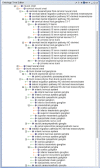A new ontology (structured hierarchy) of human developmental anatomy for the first 7 weeks (Carnegie stages 1-20)
- PMID: 22973865
- PMCID: PMC3482348
- DOI: 10.1111/j.1469-7580.2012.01566.x
A new ontology (structured hierarchy) of human developmental anatomy for the first 7 weeks (Carnegie stages 1-20)
Abstract
This paper describes a new ontology of human developmental anatomy covering the first 49 days [Carnegie stages (CS)1-20], primarily structured around the parts of organ systems and their development. The ontology includes more than 2000 anatomical entities (AEs) that range from the whole embryo, through organ systems and organ parts down to simple or leaf tissues (groups of cells with the same morphological phenotype), as well as features such as cavities. Each AE has assigned to it a set of facts of the form <AE><relationship><parent>, with the relationships including starts_at and ends_at (CSs), part_of (there can be several parents) and is_a (this gives the type of tissue, from an organ system down to one of ~ 80 simple tissues predominantly composed of a single cell kind, which is also specified). Leaf tissues also have a develops_from link to its parent tissue. The ontology includes ~14 000 such facts, which are mainly from the literature and an earlier ontology of human developmental anatomy (EHDAA, now withdrawn). The relationships enable these facts to be integrated into a single, complex hierarchy (or mathematical graph) that was made and can be viewed in the OBO-Edit browser (oboedit.org). Each AE has an EHDAA2 ID that may be useful in an informatics context, while the ontology as a whole can be used for organizing databases of human development. It is also a knowledge resource: a user can trace the lineage of any tissue back to the egg, study the changes in cell phenotype that occur as a tissue develops, and use the structure to add further (e.g. molecular) information. The ontology may be downloaded from www.obofoundry.org. Queries and corrections should be sent to j.bard@ed.ac.uk.
© 2012 The Author Journal of Anatomy © 2012 Anatomical Society.
Figures





References
-
- Bard J. Driving developmental and evolutionary change, a systems biology view. Prog Biophys Mol Biol. 2012b in press. - PubMed
-
- Bard J, Kaufman MH, Dubreuil C, et al. An internet-accessible database of mouse developmental anatomy based on a systematic nomenclature. Mech Dev. 1998;74:111–120. - PubMed
-
- Bard JB, Lam MS, Aitken S. A bioinformatics approach for identifying candidate transcriptional regulators of mesenchyme-to-epithelium transitions in mouse embryos. Dev Dyn. 2008;237:2748–2754. - PubMed
MeSH terms
LinkOut - more resources
Full Text Sources
Medical

